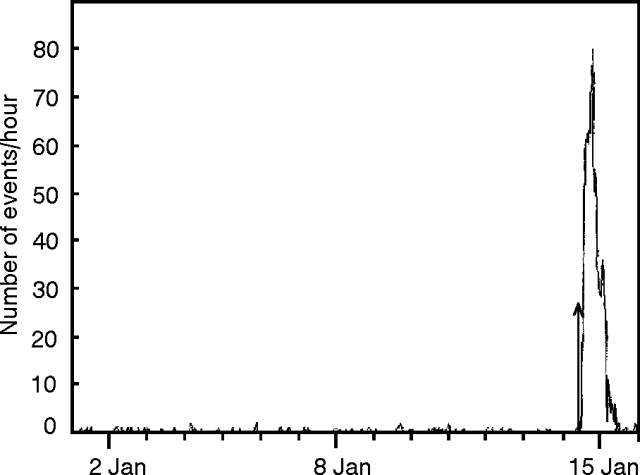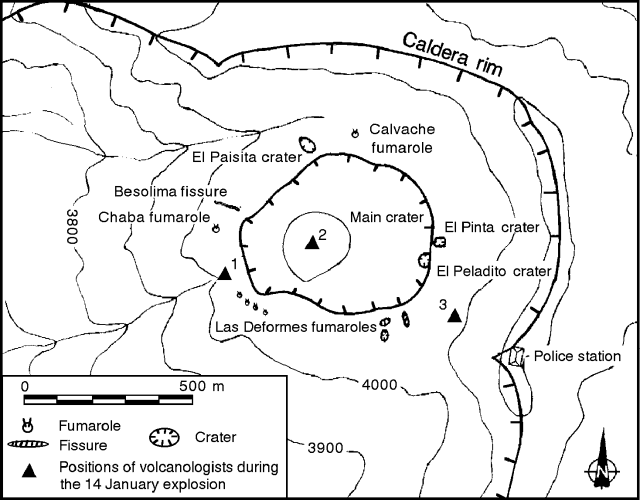Report on Galeras (Colombia) — December 1992
Bulletin of the Global Volcanism Network, vol. 17, no. 12 (December 1992)
Managing Editor: Lindsay McClelland.
Galeras (Colombia) Explosion kills nine people on the active cone, including six volcanologists
Please cite this report as:
Global Volcanism Program, 1992. Report on Galeras (Colombia) (McClelland, L., ed.). Bulletin of the Global Volcanism Network, 17:12. Smithsonian Institution. https://doi.org/10.5479/si.GVP.BGVN199212-351080
Galeras
Colombia
1.22°N, 77.37°W; summit elev. 4276 m
All times are local (unless otherwise noted)
A moderate explosive eruption on 14 January [1993] killed five people, left four others missing and presumed dead, and injured six. Most of the casualties were volcanologists attending the Galeras Volcano International Workshop. The eruption, which occurred during a workshop fieldtrip, had no immediate precursors, and was the first known explosion from the active crater since the lava dome was destroyed on 16 July.
Quoted material below is from a report by D. Gómez, R. Torres, F. Gil, and S. McNutt. Information from other sources is interspersed . . . but is not within quotes.
Seismic and eruptive activity, 1991-92. "Galeras is monitored by six short-period seismic stations 0.9-9 km from the active vent. Each station has a vertical seismometer only. During 1991-92, seismic activity was characterized by many long-period (LP) events accompanied by tremor episodes. Activity was highest in October and November 1991, with 200-360 LP events/day (figure 62). Lava-dome growth began sometime between 19 September and 9 October 1991 (16:9-10). Many ash emissions were associated with LP events and tremor. Between January and June 1992, 20-120 LP events per day were recorded. Following the 16 July 1992 eruption, which destroyed the dome (17:6-7), seismicity gradually declined to fewer than 10 events/day by December.
"High-frequency or volcano-tectonic (VT) events represent <10% of the seismicity. During 1991 and 1992, the number of these events ranged from 0-20/day. The most important VT swarms occurred a few hours before the 16 July 1992 eruption and on 1-19 August 1992. VT events also declined during the last 5 months of 1992, and occurred on only 4 days in December." Deformation data showed minor inflation at one station and continued substantial tangential deflation at another, but geologists noted that the latter may have been related to climatic changes.
Seismicity, January 1993. "During the first 2 weeks of 1993, LP events occurred at rates of 2-8/day (figure 63). No trends were observed. VT events occurred at 0-6/day (figure 64), a little higher than December 1992 rates, but similar to many other small swarms over the last 4 years.
 |
Figure 63. Number of long-period events per hour at Galeras, 1-16 January 1993. The large increase on 14 January coincides with the onset of the eruption. Courtesy of INGEOMINAS. |
 |
Figure 64. Number of high-frequency events per day at Galeras, 1-16 January 1993. Courtesy of INGEOMINAS. |
"Starting on 1 January 1993, a distinct event-type appeared, referred to as a tornillo (screw-like) event because of the nearly perfect symmetry and long coda. These are probably a special type of LP event, and are thought to represent fluid resonance in a cavity, although details are not yet known. Seventeen occurred from 1 to 14 January. Similar events have been recorded previously, but the frequency content was different. They were recorded in March 1989 (only a few), 11-16 July before the dome-destroying eruption (nine events in 5 days), and on 3 August 1992 (a single event not followed by an eruption). Frequencies of the screw-like events ranged from 1 to 3 Hz. Those in January were not all identical to each other or to events recorded earlier.
14 January 1993 eruption and aftermath. "The eruption occurred suddenly on 14 January 1993 at 1341. There were no immediate precursors in the hours before the eruption. The seismic signal associated with the eruption lasted for 15 minutes, and saturated one nearby station for 2 minutes (Crater 2). The 16 July eruption lasted 10 minutes and saturated the same station for 1 minute. The eruption plume height was estimated at 2.5-4 km above the vent, and ~30,000 m3 of material were excavated from the crater."
The active crater is at the summit of an intracaldera cone that is separated from the steep E rim of the caldera by a narrow moat (figure 65). Néstor García (Univ Nacional, Manizales, Colombia) and Igor Menyailov (Institute of Volcanology, Petropavlovsk, Russia) had been taking gas samples inside the active crater (number 2 in figure 4), and eyewitness accounts indicate that they had not left by the time of the eruption. Geoff Brown (Open Univ, Milton Keynes, UK), Fernando Cuenca (INGEOMINAS, Bogotá, Colombia), and Carlos Trujillo (CESMAG, Pasto, Colombia) had been making gravity measurements on the active cone, and were seen walking along the W side of the active crater rim ~3 minutes before the eruption (number 1 in figure 65). No survivors are known from these two groups.
José Arlés Zapata (INGEOMINAS, Pasto, Colombia), Michael Conway (Michigan Technological Univ, USA), Luis Lemarie (Escuela Politécnica, Quito, Ecuador), Andrew Macfarlane (Florida International Univ, USA), and three tourists were on the SE outer flank of the active cone (number 3 in figure 65), having descended a few tens of meters from the crater rim when the eruption occurred. Stan Williams (Arizona State Univ, USA) was above this group on the rim. Upon hearing an explosion, Conway looked back and saw a dark-gray plume that appeared to fill the crater. The activity seemed to be a typical vertical Vulcanian explosion, with projectiles leaving the main column on ballistic trajectories. A dense fall of hot ejecta began immediately on the cone's flank and soon intensified. Some of the tephra may have been as large as 1.5 m across, although most were lapilli- to fist-sized. Tongues of the convecting plume jetted 5-15 m onto the flanks of the cone, but there was no evidence of pyroclastic flows. Some incandescence was visible in the vertical column, but from his position on the flank, Conway felt no hot gases and did not need to use his gas mask. Arlés and the tourists were killed, and Williams was seriously injured. Others had less severe injuries, but all were battered and burned by the falling tephra. None of those closest to the eruption wore hardhats. The fall of large tephra ended after a few minutes, succeeded by light rain carrying clusters of ash and fine lapilli. Vigorous degassing, accompanied by a loud jetting sound, continued for several hours from the active crater, but there were no further explosions.
After large tephra stopped falling, Conway, Lemarie, and Macfarlane, although injured, were able to move slowly downslope, cross the moat and begin to climb the caldera wall. From there, rescuers brought them to the crater rim. Williams was carried out of the crater some time later. Rescue teams from the Red Cross and the Pasto volunteer fire department had arrived soon after the eruption. Several witnesses reported that Marta Calvache and Patricia Mothes, on the outer flanks of the caldera at the time of the eruption, went quickly to the scene of the disaster, assisting victims and helping to coordinate rescue efforts.
Ash- to lapilli-sized tephra (to 3 cm) from the explosion was collected by P. Mothes from the roof of a car on the E caldera rim. Examination through a binocular microscope revealed pyroxene, plagioclase, and quartz crystals, two types of vesicular fresh-looking (but not necessarily juvenile) glass, non-juvenile glass thought to be from the 1991 dome, and altered material including yellow sulfur-rich clasts. Quartz has been found in ash from previous activity at Galeras, but none in this or previous samples was surrounded by matrix glass. Quartz has also not been seen in thin sections of Galeras rocks.
"Immediately after the eruption, seismicity reached the highest levels yet recorded at Galeras; 611 LP events were recorded in 12 hours on 14 January and 150 were recorded on 15 January. Some LP events were correlated with individual pulses of gas release. An additional small ash emission, with associated tremor, occurred on 15 January at 0643. The seismicity declined quickly, reaching background levels by 16 January and remaining there as of 18 January." Rates of SO2 emission remained low, averaging 50 t/d 16-18 January.
Geological Summary. Galeras, a stratovolcano with a large breached caldera located immediately west of the city of Pasto, is one of Colombia's most frequently active volcanoes. The dominantly andesitic complex has been active for more than 1 million years, and two major caldera collapse eruptions took place during the late Pleistocene. Long-term extensive hydrothermal alteration has contributed to large-scale edifice collapse on at least three occasions, producing debris avalanches that swept to the west and left a large open caldera inside which the modern cone has been constructed. Major explosive eruptions since the mid-Holocene have produced widespread tephra deposits and pyroclastic flows that swept all but the southern flanks. A central cone slightly lower than the caldera rim has been the site of numerous small-to-moderate eruptions since the time of the Spanish conquistadors.
Information Contacts: M. Calvache, D. Gómez, and R. Torres, INGEOMINAS—Observatorio Vulcanológico del Sur; F. Gil, INGEOMINAS, Manizales; H. Cepeda and M. Monsalve, INGEOMINAS, Popayán; J-C. Komorowski, Instituto de Geofísica, UNAM, México; D. Lescinsky, Arizona State Univ; S. McNutt, Univ of Alaska; M. Conway, Michigan Technological Univ; C. Connor, CNWRA, San Antonio; C. Wood, Univ of North Dakota.



